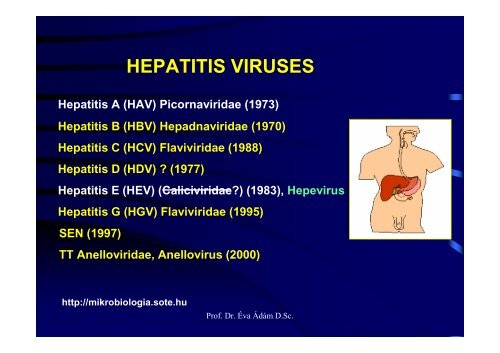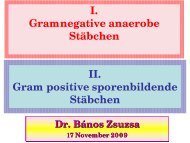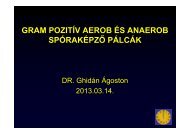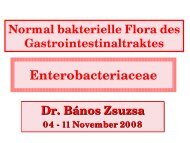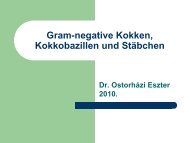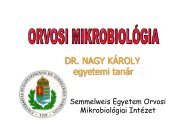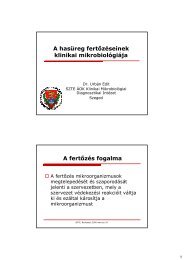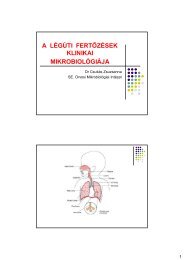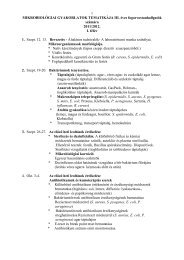HEPATITIS VIRUSES
HEPATITIS VIRUSES
HEPATITIS VIRUSES
You also want an ePaper? Increase the reach of your titles
YUMPU automatically turns print PDFs into web optimized ePapers that Google loves.
Hepatitis A (HAV) Picornaviridae (1973)<br />
Hepatitis B (HBV) Hepadnaviridae (1970)<br />
Hepatitis C (HCV) Flaviviridae (1988)<br />
Hepatitis D (HDV) ? (1977)<br />
Hepatitis E (HEV) (Caliciviridae?) (1983), Hepevirus<br />
Hepatitis G (HGV) Flaviviridae (1995)<br />
SEN (1997)<br />
TT Anelloviridae, Anellovirus (2000)<br />
http://mikrobiologia.sote.hu<br />
<strong>HEPATITIS</strong> <strong>VIRUSES</strong><br />
Prof. Dr. Éva Ádám D.Sc.
Hepatitis: infectious liver disease of<br />
various viral origin (symptoms: fatigue,<br />
joint- and abdominal pain, malaise,<br />
vomiting, lack of appetite, hepatomegaly)<br />
Icterus: jaundice (skin, sclera, mucous membranes,<br />
cause: elevated bilirubin level, bilirubinuria: dark urine, pale stool)<br />
Prof. Dr. Éva Ádám D.Sc.<br />
stool
<strong>HEPATITIS</strong> <strong>VIRUSES</strong> TRANSMITTED<br />
FECAL ORAL ROUTE<br />
Hepatitis A virus<br />
Hepatitis E virus<br />
Prof. Dr. Éva Ádám D.Sc.
CLASSIFICATION OF PICORNA<strong>VIRUSES</strong><br />
ENTEROVIRUS GENUS<br />
POLIOVIRUS 1-3 1<br />
Coxsackie viruses A1-A24 A1 A24 (type ( type 23: no)<br />
B1-B6 B1 B6<br />
Echoviruses 1-34 34 (types ( types 10 and 28: no)<br />
Enteroviruses 68-71 68 71<br />
Rhinoviruses 1-110 110<br />
HEPATOVIRUS GENUS<br />
<strong>HEPATITIS</strong> A VIRUS<br />
APHTHOVIRUS GENUS<br />
Prof. Dr. Éva Ádám D.Sc.<br />
pH stable<br />
pH sensitive
Prof. Dr. Éva Ádám D.Sc.
• faecal-oral transmission( hands, foods, water,<br />
„frutta di mare”)<br />
• Replication: hepatocytes (focal necrosis)<br />
• Latency: rather short (10- 45 days)<br />
• Asymptomatic, symptoms with or without icterus<br />
• Icterus: > 6 years 10 %, < 14 years 70%, fever, malaise, vomiting,<br />
• Hepatocyte lesion (low) → regeneration→ regeneration complete recovery<br />
• Complications: rare<br />
Prof. Dr. Éva Ádám D.Sc.
PREVALENCE OF <strong>HEPATITIS</strong> A VIRUS<br />
(ANTIBODIES)<br />
Prof. Dr. Éva Ádám D.Sc.
Diagnosis: HAV specific IgM, or antigen detection, IEM (virus in<br />
stool)<br />
Prof. Dr. Éva Ádám D.Sc.
PREVENTION and CONTROL<br />
• Endemic areas: boiled drinking water, avoid raw<br />
shellfish, vegetables<br />
• Hand disinfection<br />
• Vaccination of seronegative persons (suggested for<br />
people traveling to infected areas, after disasters<br />
/flood disaster/ inactivated virus i.m.)<br />
• Passive immunization (HAIG):<br />
contacts of sick patients<br />
Prof. Dr. Éva Ádám D.Sc.
Hepeviridae,<br />
Hepevirus genus<br />
33 nm, icosahedral,<br />
(ss + RNA, genome:<br />
similar to rubella virus<br />
(Togaviridae)<br />
Hepatitis E virus<br />
• Fecal-oral transmission (water!) great epidemics (China, India),<br />
heat and acid stable, zoonosis! (pig 1997, dog, chicken, rat), very<br />
rarely: transfusion<br />
• Latency: 15-60 days<br />
• Symptoms as in the case of HAV (mild disease, no chronic<br />
disease or chronic carrier state) self-limiting<br />
• Europe: sporadic only<br />
• Complications: in pregnant woman 25% with high mortality!!!<br />
(DIC)<br />
Prof. Dr. Éva Ádám D.Sc.
<strong>HEPATITIS</strong> E VIRUS INFECTION: DIAGNOSIS<br />
• anti-HEV Ig ELISA<br />
Control: for pregnant woman HEIG (antibody) in the endemic areas,<br />
vaccine (recombinant Baculovirus, clinical phase 2, USA, Nepal)<br />
Prof. Dr. Éva Ádám D.Sc.
PREVALENCE OF <strong>HEPATITIS</strong> E VIRUS<br />
Prof. Dr. Éva Ádám D.Sc.
PARENTERALLY TRANSMITTED<br />
<strong>HEPATITIS</strong> <strong>VIRUSES</strong><br />
Hepatitis B virus<br />
Hepatitis C virus<br />
Hepatitis D virus<br />
Hepatitis G virus<br />
Prof. Dr. Éva Ádám D.Sc.
<strong>HEPATITIS</strong> B VIRUS (HBV)<br />
HEPADNA VIRIDAE<br />
ORTHOHEPADNAVIRUS<br />
AVIHEPADNAVIRUS<br />
Prof. Dr. Éva Ádám D.Sc.
VIRION: cubical, peplon<br />
Dane particle, 42 nm infectious<br />
Au-antigen (HBsAg),<br />
antigen determinants:<br />
a: group specific,<br />
subdeterminants: d/y and w/r:<br />
(adw, ayw, adr, ayr fenotypes)<br />
22 nm HBc and HBe antigens<br />
(core)<br />
NUCLEIC ACID: partially ds DNA,<br />
circular (longer chain +, shorter<br />
chain -), special polymerase<br />
B. Blumberg<br />
(1976. Nobel Prize)<br />
Prof. Dr. Éva Ádám D.Sc.
TRANSMISSION OF HBV<br />
• Parenteral: i.v. drug users, accidental pricking, health-care workers<br />
• Hemodialysis<br />
• Perinatal (HBeAg positive mothers)<br />
• Sexual: sex workers<br />
• High virus concentration: blood, serum, wounds exudate<br />
• Moderate virus concentration: semen, vaginal fluid, saliva<br />
• HBV survives on surfaces min. 1 week<br />
****<br />
Latency: 45-180 days<br />
Icterus (jaundice): < 5 years 30-50<br />
Acute death (fulminant hepatitis): 0,5- 1 %<br />
Chronic infection: > 5 years 30-90% , < 5 years 2-10%<br />
Chronic persistant hepatitis: asymptomatic<br />
Chronic active hepatitis: symptomatic<br />
Prof. Dr. Éva Ádám D.Sc.
Adults and elderly children: 90-99%<br />
Newborn babies and children: 5-20%<br />
POSSIBLE OUTCOMES<br />
Adults and elderly children : 1-10% 1 10%<br />
Newborn babies and children: : 80-95 80 95 %<br />
ACUTE INFECTION CHRONIC INFECTION<br />
Subclinical<br />
Fulminant<br />
hepatitis<br />
Hepatitis with icterus (adults)<br />
Cirrhosis<br />
Extrahepatic: arthritis,<br />
polyarthritis, glomerulonephritis<br />
Asymptomatic Chronic persistent<br />
hepatitis<br />
Chronic active hepatitis<br />
Hepatocellular<br />
carcinoma<br />
Prof. Dr. Éva Ádám D.Sc.<br />
ascites in the abdomen
Outcome of HBV<br />
infection:<br />
dependent on the<br />
immune function<br />
Newborn babies:<br />
immatured immune system<br />
(T cytotoxic system),<br />
antibodies from the mother<br />
induce ADCC (Antibody<br />
Dependent Cellular<br />
Cytotoxicity) reaction<br />
Adults: steroid treatment<br />
(decrease of T cytotoxic<br />
activity), AIDS: no T-helper<br />
cells<br />
Prof. Dr. Éva Ádám D.Sc.
ACUTE <strong>HEPATITIS</strong> B VIRUS<br />
INFECTION<br />
Jaundice<br />
HBsAg<br />
HBeAg<br />
ALT<br />
Anti-HBc<br />
0 1 2 3 4 5 6 12 24 month<br />
Markers: antigens (HBsAg, HBeAg),<br />
antibodies (anti-HBs, -HBc, -HBe)<br />
Prof. Dr. Éva Ádám D.Sc.<br />
Anti -HBs<br />
Anti-HBe
CHRONIC <strong>HEPATITIS</strong> B VIRUS<br />
INFECTION<br />
symptoms<br />
HBeAg<br />
HBsAg<br />
1 2 3 4 5 6 months 2 4 6 8 10 years<br />
Chronic hepatitis B virus infection: HBsAg, anti-HBc<br />
Prof. Dr. Éva Ádám D.Sc.<br />
Anti-HBc<br />
Anti-HBe<br />
Chronic active hepatitis B: HBeAg, HBV polymerase, Dane particle,<br />
anti-HBe
SURVIVAL IN CHRONIC <strong>HEPATITIS</strong> B<br />
VIRUS INFECTION<br />
80<br />
60<br />
40<br />
20<br />
Rate of survival %100<br />
Outcome is dependent on<br />
period of virus replication,<br />
severity of liver cell destruction<br />
(alcohol, drugs), HDV infection<br />
5 10 15 20 years<br />
Prof. Dr. Éva Ádám D.Sc.<br />
Chronic persistant<br />
hepatitis<br />
Chronic active<br />
hepatitis<br />
Chronic active<br />
hepatitis with<br />
cirrhosis<br />
HBV carriers: about 300 millions (40 %<br />
cirrhosis, carcinoma), 6 millions death/year,<br />
120 millions babies/year (chronic carrier<br />
state)
PREVALENCE OF HBV SURFACE ANTIGEN (HBsAg)<br />
Prof. Dr. Éva Ádám D.Sc.
CONTROL<br />
HBsAg produced by recombinant DNA technology<br />
Obligatory in age group 14 and for newborn<br />
babies of HBsAg positive mothers (Hungary)<br />
Preexposure/postexposure vaccination<br />
Priority candidates for Hepatitis B Vaccine<br />
newborn babies of HBsAg positive mothers<br />
sexual and close household contacts of HBV carriers<br />
needle-stick injuries from HBV carriers<br />
parenteral drug abusers<br />
homosexually active men<br />
heterosexually promiscuous persons (prostitutes)<br />
hemophiliacs, hemodialysis patients<br />
health care and public safety workers potentially<br />
exposed to human blood<br />
immuno-suppressed or cancer patients<br />
Combined vaccine: TWINRIX (HAV+HBV)<br />
Prof. Dr. Éva Ádám D.Sc.
<strong>HEPATITIS</strong> D VIRUS<br />
(HDV, DELTA AGENT)<br />
VIRION: spherical, 36-38 nm,<br />
HBV capsid, HDV nucleoprotein<br />
NUCLEIC ACID: (-) ss RNA, circular<br />
Satellite virus : replicates only<br />
in the presence of HBV<br />
Prof. Dr. Éva Ádám D.Sc.
Prof. Dr. Éva Ádám D.Sc.
COINFECTION or SUPERINFECTION<br />
ALT<br />
Anti-HBs<br />
Anti-HDV IgG<br />
Anti HDV IgM<br />
HBsAg<br />
HDV RNA<br />
Prof. Dr. Éva Ádám D.Sc.<br />
ALT<br />
Anti-<br />
HDV<br />
IgG<br />
Anti HDV IgM
<strong>HEPATITIS</strong> C VIRUS (HCV ( )<br />
FLAVIVIRIDAE<br />
Hepacivirus genus<br />
Prof. Dr. Éva Ádám D.Sc.
VIRION: spherical, icosahedral,<br />
NUCLEIC ACID: ss (+) RNA<br />
Prof. Dr. Éva Ádám D.Sc.
• virus previously identified as NANB virus (50 % of isolates are<br />
HCV (posttransfusional hepatitis)<br />
• diseases are mainly subclinical, about in one half of the cases chronic<br />
hepatitis develops ( cirrhosis)<br />
• HCV infection is major risk factor for the development of hepatocellular<br />
carcinoma /HCC/ (anti -HCV in the serum or HCV RNA is detectable)<br />
• in southern Europe and Japan: 50-75 % of patients with HCC have<br />
evidence for HCV infection<br />
• precise mechanism is unknonw (inflammation, chronic hepatitis, cirrhosis)<br />
Prof. Dr. Éva Ádám D.Sc.
Comparison of<br />
HBV and HCV<br />
transmission<br />
Prof. Dr. Éva Ádám D.Sc.
OUTCOMES of HCV hepatitis<br />
Prof. Dr. Éva Ádám D.Sc.
15-30%<br />
recovery<br />
Acute HCV infection<br />
70-85 %<br />
Prof. Dr. Éva Ádám D.Sc.<br />
Chronic disease<br />
chronic hepatitis C<br />
mild moderate severe<br />
Hepatocellular<br />
carcinoma<br />
DEATH<br />
cirrhosis<br />
Very severe liver disease<br />
Liver transplantation
Serologic Pattern of Acute HCV Infection<br />
with Recovery<br />
Titer<br />
Symptoms +/-<br />
HCV RNA<br />
Normal<br />
ALT<br />
0 1 2 3 4 5 6 1 2 3 4<br />
Years<br />
Months<br />
Prof. Dr. Éva Ádám D.Sc.<br />
anti-HCV
Serologic Pattern of Acute HCV Infection<br />
with Progression to Chronic Infection<br />
Titer<br />
Symptoms +/-<br />
HCV RNA<br />
Normal<br />
0 1 2 3 4 5 6 1 2 3 4<br />
Years<br />
Months<br />
Prof. Dr. Éva Ádám D.Sc.<br />
anti-HCV<br />
ALT
Diagnosis<br />
• anti-HCV Ig (ELISA, Western blot)<br />
• HCV core ag (ELISA)<br />
• HCV RNA detection (RT-PCR), in<br />
acute phase and in monitoring the<br />
response of therapy<br />
• 4-6 weeks “Windows” period<br />
Prof. Dr. Éva Ádám D.Sc.
HCV PREVALENCE IN BLOOD DONORS<br />
Prof. Dr. Éva Ádám D.Sc.
THERAPY<br />
• interferon<br />
• ribavirin<br />
• liver transplantation<br />
PREVENTION<br />
• donor screening<br />
• change the behavior of risk groups<br />
• safe handling of body fluids ( blood, serum)<br />
• future: recombinant vaccine under development (human clinical<br />
trial)<br />
Prof. Dr. Éva Ádám D.Sc.
others<br />
unknown<br />
alcohol<br />
Prof. Dr. Éva Ádám D.Sc.<br />
HBV and alcohol<br />
HCV and alcohol<br />
Cause of severe destruction of liver cells (chronic<br />
hepatitis)
<strong>HEPATITIS</strong> G VÍRUS<br />
FLAVIRUS: similar morphology and genom<br />
◊ in risk groups: acute, chronic and fulminant hepatis<br />
◊ transmission: blood (mother- newborn babies)<br />
◊ prevalence is higher in HCV infected people<br />
Prof. Dr. Éva Ádám D.Sc.
TT VIRUS<br />
- 1997. Japan (Torque Teno, TT virus, Torque Teno Minivirus,<br />
TTMV)<br />
- circular ss DNA, naked, from 40 genotypes 2 are causative<br />
agents of hepatitis, supposed taxonomy: Anelloviridae,<br />
genus Anellovirus)<br />
- presence: serum, stool, liver cells replication (spreading:<br />
enteral and parenteral<br />
SEN VIRUS<br />
- 2000 Italy (in hepatitis with unknown origin)<br />
- the genom is similar to TT virus genom, 8 genotypes<br />
Prof. Dr. Éva Ádám D.Sc.


